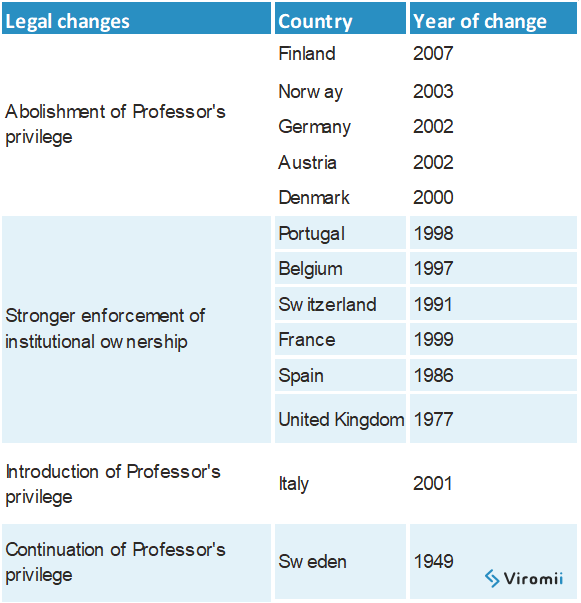Universities are the cradle of knowledge, new technologies and innovation. These new technologies and innovations can be the base for successful high-technology companies, or they can be of interest for external partners who might be willing to acquire or license-in them. The way these intangible assets are controlled, and formally owned, is through intellectual property rights (IPRs), mainly patents, when talking about technical developments.
Until the 80s, the ownership structure of university-based innovations widely varied among the different countries. In some countries such as US, Germany or Sweden, the researchers were the owners of their developments, what is called the “Professor’s privilege”, whereas in other countries such as Spain or UK there was already a strong enforcement of institutional ownership. However, the 1980 U.S. Bayh-Dole Act, lead a change, and universities became the main owner of innovations developed at the by their researchers. This model was slowly implemented by most of the European countries where “Professor’s privilege” was still a reality, and at this moment only Italy and Sweden keep this privilege.
*Data from Catalina Martinz, WIPO 2018.
From the moment in which universities became the main owners of the university-based innovations they got the responsibility of transferring and exploiting them, and this was the moment in which most of the technology-transfer offices (TTOs) were born. One of the main arguments used to support the abolishment of “Professor’s privilege” is that universities are more successful than professor’s when commercializing innovations.
The previous affirmation has long been a source of controversy and despite there is a lot of research in the field it remains a hot topic with no clear answer. However, from Viromii we do not think that this is the right question. The rate of commercialization and transference of university-based innovations is not related to the fact that a country has the “Professor’s privilege” or not. Taking Sweden and The Netherlands as examples, both are ranked among the top countries in the world regarding innovation and technology transfer, in Sweden the “Professor’s privilege” principle is applied, but not in The Netherlands. Contrary, we have the case of Spain, where universities are the owners, and Italy, following the “Professor’s privilege” from 2001, both scoring quite low in innovation impact and technology transfer.
As it can be seen from the examples, IP ownership is not the main factor influencing the success and impact of innovation and technology transfer, there are other relevant social and political factors that can trigger, improve, and incentivize technology transfer and value creation from university-based innovations; the focus should be put on identifying these factors and creating an environment that fosters and facilitates technology transfer processes. One of the factors that Viromii has identified is the closeness and relations between industry and universities, universities that work towards increasing their industrial network are better at transferring their innovations. This is why, at Viromii, we are working with TTOs to increase their visibility and connecting them with industrial partners, in order to assure long-term relations that will create value and returns in terms of technology and knowledge transfer.
Sources:

